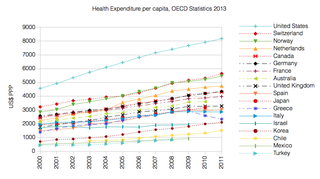
Slovakia had the fourth highest rate of death from communicable disease in Europe in 2015, at 35 per 100,000 population. [1]
Contents
Slovakia has public (obligatory) health insurance. [2]

Slovakia had the fourth highest rate of death from communicable disease in Europe in 2015, at 35 per 100,000 population. [1]
Slovakia has public (obligatory) health insurance. [2]
The Euro health consumer index ranked Slovakia 24th of 35 European countries in 2015, noting that a system of private additional healthcare insurance has recently been established. [3]
Universal health care is a health care system in which all residents of a particular country or region are assured access to health care. It is generally organized around providing either all residents or only those who cannot afford on their own, with either health services or the means to acquire them, with the end goal of improving health outcomes.
Health care in Ireland is delivered through public and private healthcare. The public health care system is governed by the Health Act 2004, which established a new body to be responsible for providing health and personal social services to everyone living in Ireland – the Health Service Executive. The new national health service came into being officially on 1 January 2005; however the new structures are currently in the process of being established as the reform programme continues. In addition to the public-sector, there is also a large private healthcare market.

The European Health Insurance Card (EHIC) is issued free of charge and allows anyone who is insured by or covered by a statutory social security scheme of the EEA countries, Switzerland, and the United Kingdom to receive medical treatment in another member state in the same way as residents of that state—i.e., free or at a reduced cost—if treatment becomes necessary during their visit, or if they have a chronic pre-existing condition which requires care such as kidney dialysis. The term of validity of the card varies according to the issuing country. Continued reciprocal healthcare access between the EU and the UK was agreed, and the UK issues a UK Global Health Insurance Card (GHIC) valid in the EU, but not other EEA countries.

Switzerland has universal health care, regulated by the Swiss Federal Law on Health Insurance. There are no free state-provided health services, but private health insurance is compulsory for all persons residing in Switzerland.
Families USA is a nonprofit, nonpartisan consumer health advocacy and policy organization.

Healthcare in the Netherlands is differentiated along three dimensions (1) level (2) physical versus mental and (3) short term versus long term care.

Spain operates a universal health care system. According to the Organisation for Economic Co-operation and Development, total health spending accounted for 9.4% of GDP in Spain in 2011, slightly above the OECD average of 9.3%. Spain's healthcare system ranks 19th in Europe according to the 2018 Euro health consumer index. As of 2016, Spain is ranked 1st in the world in organ transplants.

Health care in Poland is insurance based, delivered through a publicly funded health care system called the Narodowy Fundusz Zdrowia, which is free for all the citizens of Poland provided they fall into the "insured" category. According to Article 68 of the Polish Constitution everyone has a right to have access to health care. Citizens are granted equal access to the publicly funded healthcare system. In particular, the government is obliged to provide free health care to young children, pregnant women, disabled people, and the elderly. However, private health care use is very extensive in Poland. Patients who are uninsured have to pay the full cost of medical services. According to a study conducted by CBOS in 2016, out of 84% patients taking part in the survey, 40% declared use of both private and public health services, 37% use only public health care, and 7% use only private health services. 77% of all responders declared using private health care is caused by long waiting for public health care services.

Health care in Cyprus accounted for 7% of its GDP in 2014. Between 2010 and 2014, health care spending increased from $1,705 per capita to $2,062 per capita. Cyprus has a multi-payer health care system that consists of a public and private sector. The public sector is funded by payroll, earnings taxes, and employer contributions. The public sector healthcare provides social insurance for the employed, self-employed, and for several types of civil servant.

Hungary has a tax-funded universal healthcare system, organized by the state-owned National Health Insurance Fund. While healthcare is considered universal, several reasons persist preventing Hungarian nationals to access healthcare services. For instance, a Hungarian citizen who lived abroad but is unable to show contributions to another country's healthcare system will not be able to access the Hungarian healthcare system free of charge. However, to the OECD, 100% of the total population is covered by universal health insurance, which is absolutely free for children, mothers or fathers with babies, students, pensioners, people with low income, handicapped people, priests and other church employees. In 2022 the cost of public health insurance is 8,400 HUF per month which is the equivalent of $23.69. The healthcare system underwent significant changes which also resulted in improving life expectancy and a very low infant mortality rate. According to the OECD Hungary spent 7.8% of its GDP on health care in 2012. Total health expenditure was $US1,688.7 per capita in 2011, US$1,098.3governmental-fund (65%) and US$590.4 private-fund (35%).

Healthcare in Slovenia is organised primarily through the Health Insurance Institute of Slovenia. In 2015, healthcare expenditures accounted for 8.10% of GDP. The Slovenian healthcare system was ranked 15th in the Euro health consumer index 2015. The country ranked second in the 2012 Euro Hepatitis Index.

Healthcare in the United States is largely provided by private sector healthcare facilities, and paid for by a combination of public programs, private insurance, and out-of-pocket payments. The U.S. is the only developed country without a system of universal healthcare, and a significant proportion of its population lacks health insurance. The United States spends more on healthcare than any other country, both in absolute terms and as a percentage of GDP; however, this expenditure does not necessarily translate into better overall health outcomes compared to other developed nations. Coverage varies widely across the population, with certain groups, such as the elderly and low-income individuals, receiving more comprehensive care through government programs such as Medicaid and Medicare.
Croatia has a universal health care system, whose roots can be traced back to the Hungarian-Croatian Parliament Act of 1891, providing a form of mandatory insurance of all factory workers and craftsmen. The population is covered by a basic health insurance plan provided by statute and optional insurance and administered by the Croatian Health Insurance Fund. In 2012, annual compulsory healthcare related expenditures reached 21.0 billion kuna.

The nation of Austria has a two-tier health care system in which virtually all individuals receive publicly funded care, but they also have the option to purchase supplementary private health insurance. Care involving private insurance plans can include more flexible visiting hours and private rooms and doctors. Some individuals choose to completely pay for their care privately.

Healthcare in Greece consists of a universal health care system provided through national health insurance, and private health care. According to the 2011 budget, the Greek healthcare system was allocated 6.1 billion euro, or 2.8% of GDP. In a 2000 report by the World Health Organization, the Greek healthcare system was ranked 14th worldwide in the overall assessment, above other countries such as Germany (25) and the United Kingdom (18), while ranking 11th at level of service.
Euro Health Consumer Index (EHCI) was a comparison of European health care systems based on waiting times, results, and generosity. The information is presented as a graphic index. EHCI was produced 2005–2009 and 2012–2018 by Health Consumer Powerhouse. The 2014 ranking included 37 countries measured by 48 indicators. It claimed to measure the "consumer friendliness" of healthcare systems. It did not claim to measure which European state had the best healthcare system, but it did produce specialist Indexes on Diabetes, Cardiac Care, HIV, Headache and Hepatitis.

A new measure of expected human capital calculated for 195 countries from 1990 to 2016 and defined for each birth cohort as the expected years lived from age 20 to 64 years and adjusted for educational attainment, learning or education quality, and functional health status was published by The Lancet in September 2018. Latvia had the twenty-first highest level of expected human capital with 23 health, education, and learning-adjusted expected years lived between age 20 and 64 years.

The Czech Republic has a universal health care system, based on a compulsory insurance model, with fee-for-service care funded by mandatory employment-related insurance plans since 1992. According to the 2018 Euro health consumer index, a comparison of healthcare in Europe, the Czech healthcare is ranked 14th, just behind Portugal and two positions ahead of the United Kingdom.

The Health in North Macedonia is improving. The Macedonian life expectancy in 2016 was 74 for men and 78 for women. In 2015 it was estimated that 11.44% of the Macedonian population had diabetes, costing about $403 per person per year. In 2015 it had the fourth highest rate of death from non-communicable diseases in Europe.

Healthcare in Slovakia has features of the Bismarck, the Beveridge and the National Health Insurance systems. It has public health system paid largely from taxation. The cost of national health insurance is shared between the employees and the employers. The part of these taxes are paid by the employees as a deduction from theirs wages and the remaining part of these taxes is paid as compulsory contribution by employers. Sole traders pay the full amount of these taxes.